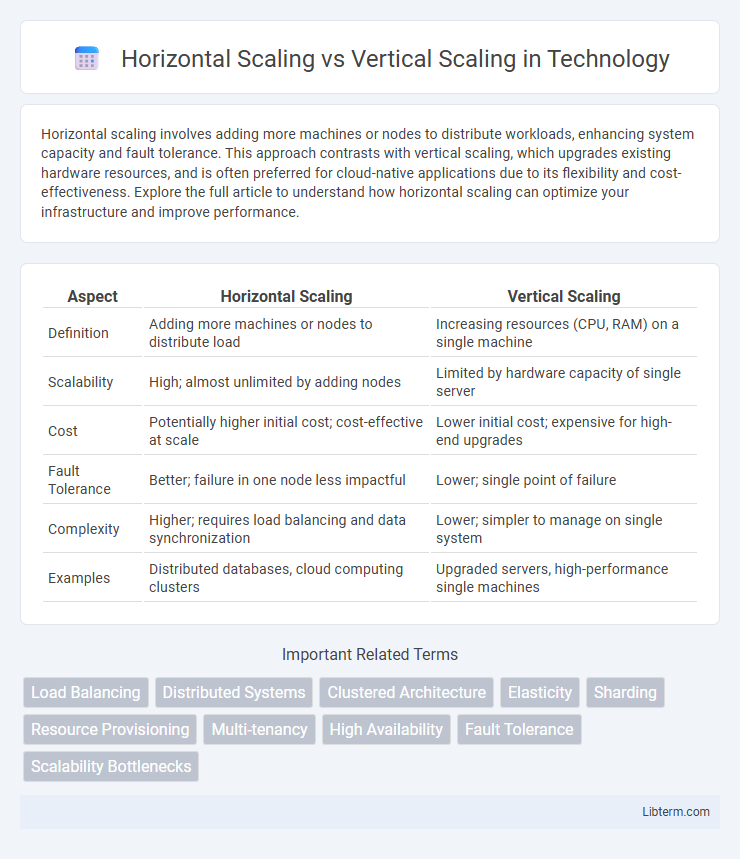Horizontal scaling involves adding more machines or nodes to distribute workloads, enhancing system capacity and fault tolerance. This approach contrasts with vertical scaling, which upgrades existing hardware resources, and is often preferred for cloud-native applications due to its flexibility and cost-effectiveness. Explore the full article to understand how horizontal scaling can optimize your infrastructure and improve performance.
Table of Comparison
| Aspect | Horizontal Scaling | Vertical Scaling |
|---|---|---|
| Definition | Adding more machines or nodes to distribute load | Increasing resources (CPU, RAM) on a single machine |
| Scalability | High; almost unlimited by adding nodes | Limited by hardware capacity of single server |
| Cost | Potentially higher initial cost; cost-effective at scale | Lower initial cost; expensive for high-end upgrades |
| Fault Tolerance | Better; failure in one node less impactful | Lower; single point of failure |
| Complexity | Higher; requires load balancing and data synchronization | Lower; simpler to manage on single system |
| Examples | Distributed databases, cloud computing clusters | Upgraded servers, high-performance single machines |
Introduction to Scaling in IT Infrastructure
Horizontal scaling involves adding more servers or machines to distribute workloads, enhancing system capacity and fault tolerance without downtime. Vertical scaling increases the power of existing hardware by upgrading CPUs, memory, or storage to handle higher loads, often limited by physical constraints. Effective IT infrastructure scaling balances these approaches to optimize performance, cost, and flexibility based on application demands and resource availability.
What is Horizontal Scaling?
Horizontal scaling, also known as scaling out, involves adding more machines or nodes to a system to distribute the workload and improve performance. This approach enhances fault tolerance and scalability by allowing applications to handle increased traffic through multiple servers or instances. Unlike vertical scaling, which upgrades existing hardware, horizontal scaling leverages load balancing and clustering to achieve greater flexibility and resource availability.
What is Vertical Scaling?
Vertical scaling involves increasing the capacity of a single server or machine by adding more CPU, RAM, or storage to handle higher workloads. It enhances performance by upgrading existing hardware resources without changing the system architecture. Vertical scaling is ideal for applications requiring strong consistency and low latency within a single node environment.
Key Differences Between Horizontal and Vertical Scaling
Horizontal scaling involves adding more servers or nodes to distribute workloads, enhancing system capacity and fault tolerance without downtime. Vertical scaling upgrades existing hardware by increasing CPU, RAM, or storage, improving performance but often limited by hardware constraints. Horizontal scaling offers better scalability and redundancy, while vertical scaling provides simpler implementation and better support for legacy applications.
Use Cases for Horizontal Scaling
Horizontal scaling is ideal for applications requiring high availability and fault tolerance, such as distributed databases, web servers, and cloud-native microservices architectures. It supports dynamic workload management by adding multiple machines, enabling rapid response to increased traffic without downtime. Common use cases include large-scale e-commerce platforms, real-time data processing systems, and SaaS applications demanding seamless scalability and resilience.
Use Cases for Vertical Scaling
Vertical scaling suits applications with limited downtime tolerance and where upgrading server capabilities, such as CPU, RAM, or storage, can significantly enhance performance without architectural changes. It is ideal for database systems like Oracle or SQL Server that handle large transactions on a single machine. Environments requiring quick performance boosts without the complexity of distributed systems benefit greatly from vertical scaling.
Pros and Cons of Horizontal Scaling
Horizontal scaling offers improved fault tolerance and increased capacity by adding multiple servers or nodes, enabling distributed workloads and minimizing single points of failure. It provides enhanced flexibility for scaling out resources based on demand but may introduce complexity in data consistency and network latency challenges. Cost efficiency in cloud environments can be significant, though management overhead and synchronization issues require robust orchestration tools.
Pros and Cons of Vertical Scaling
Vertical scaling enhances system performance by upgrading existing hardware resources such as CPU, RAM, or storage, offering simplicity in management and reduced downtime during implementation. Limitations include scalability caps tied to physical hardware constraints and potential high costs associated with premium equipment upgrades. Dependency on a single machine increases the risk of a complete system failure, impacting availability and fault tolerance compared to distributed architectures.
Choosing the Right Scaling Strategy
Choosing the right scaling strategy depends on your system's architecture and workload demands, where horizontal scaling involves adding more servers to distribute load, improving fault tolerance and accommodating increased traffic. Vertical scaling enhances performance by upgrading existing hardware resources like CPU and memory, ideal for applications requiring strong consistency and minimal latency. Evaluating application architecture, budget constraints, and scalability goals ensures an optimal balance between cost efficiency and performance.
Future Trends in Infrastructure Scaling
Future trends in infrastructure scaling emphasize hybrid approaches combining horizontal and vertical scaling to optimize resource utilization and performance. Advances in containerization, microservices, and edge computing drive more dynamic horizontal scaling, allowing systems to expand seamlessly across distributed environments. Meanwhile, improvements in hardware capabilities and virtualization technologies enable more efficient vertical scaling, enhancing single-node performance to handle increasing workloads.
Horizontal Scaling Infographic

 libterm.com
libterm.com